November 1, 2010
By Pamela J. Waterman
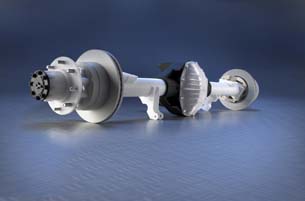 Axel assembly of FDM parts made on a Fortus system. Individual part materials include ABS, PC, PC/ABS blend, PPSF and ABSi. Length is approximately 3 feet. Image courtesy Stratasys. |
Have you heard bits and pieces about additive manufacturing (AM) but don’t quite know what differentiates the technologies? This month DE goes back to basics and clarifies the alphabet soup of AM processes and systems. Whether your interest is for prototyping, manufacturing, artwork or amusement, we’ll give you an overview of options that can meet or surpass your needs.
Variety Among AM Technologies
Remember how watches were just watches until digital versions came along? And suddenly you had to differentiate between digital and analog versions? A parallel situation exists with building parts: machining is really “subtractive manufacturing” that cuts away an oversized solid material chunk until you get the desired shape. The process can be very quick, you can create highly accurate parts and you can work with a great variety of materials; however, achievable geometry is limited and costs can include large amounts of wasted material.
Conversely, additive manufacturing systems start with just a bit of raw material, generally in sheet, liquid, filament or powder form. Guided by a 3D CAD model for a pattern, AM equipment builds parts up layer by layer to create a physical solid. The benefits of the process are many, and one or more of them apply whether you need a single prototype, a number of very different final parts, a thousand almost-identical parts, or a custom one-off piece.
You could say that casting and injection-molding represent a third type of manufacturing process, but the traditional approach to creating these intermediate-step forms still depends on machining, and once built can be difficult or impossible to change.
Additive manufacturing is an umbrella term for the growing market of international systems that produce a mind-boggling variety of parts and assemblies. (See “The New Math of Manufacturing: Subtractive or Additive?”). In just over 20 years, the variety of attractive options has expanded from the original technology—a stereolithography apparatus (SLA) approach—to dozens of astoundingly creative and different approaches. For an in-depth look at systems and the business market, check out Wohlers Report 2010 by Terry Wohlers (see Sidebar “Wohlers Report 2010 — The Annual AM Roundup”).
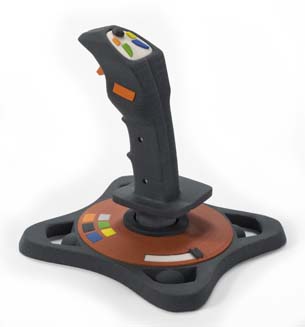 A full-size, full-color joystick model created with the 3D printing process on a ZPrinter 650 from ZCorp. Image courtesy Z Corporation. |
The ABCs of AM Systems
When looking into various AM systems (hardware, control software and build materials), you’ll find that the basic differences lie in speed, accuracy and material types, which affect both initial and long-term usage costs. Some systems are more appropriate for high-volume manufacturing, others for office-environment production, and still others for desktop prototyping, yet even there the lines blur. Be sure to ask about material reuse, as-built surface quality, any optional (or required) finishing steps, and properties such as thermal stability or chemical resistance.
Add to this mix the possibility of building or using very low-cost equipment (see Sidebar “The Must-Have Guide to Open-Source 3D Printers” on page XX) and you’ll see it pays to become an informed consumer.
3D printing is an umbrella term for AM because it presents an easily understood vision of transitioning from paper copies to solid models. A decade ago this often referred to a process licensed by MIT to five different end-users, two of which still exist with a very strong market presence: Z Corporation and ExOne. The 3D printing process uses a standard 2D inkjet print head to spray patented binder liquids onto powdered base materials, tracing and hardening the layers of a 3D CAD model.
ZCorp. offers two composite materials: plaster-based and cellulose-based. The cellulose-based material is suited to infiltration with an elastomer to create rubber-like parts. ExOne creates both direct-metal parts (in stainless steel infiltrated with bronze or gold) and sand cores and molds for metal casting.
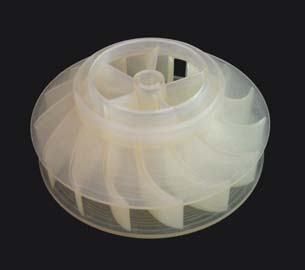
Aerosol Jet technology, from Optomec, differs from inkjet processes. It precisely delivers fluid and nanomaterial formulations, producing electronic, structural and biological patterns on almost any substrate. The approach uses aerodynamic focusing to deposit atomized materials, which can be optionally post-treated with a focused laser or other sintering methods.
Digital Light Processing (DLP), a Texas Instruments process, is the technology behind Envisiontec’s line of AM equipment (ZCorp also markets a DLP system based on an OEM agreement with Envisiontec). This approach uses a series of micro-mirrors to reflect light (UV) through projected, 3D-CAD-created masks to solidify layers of various photopolymers.
Direct Metal Deposition (DMD) describes the approach that the POM Group takes to create and also repair metal parts made in tool steel, titanium, Inconel and other alloys. One system offers an evacuated chamber for special alloy processing, fabricating fully dense metal “from the ground up” using powdered metal and a focused laser. Another system is configured as a portable robotic arm that brings the machine to the part for shopfloor repair of massive tooling. Dissimilar metals can be combined as needed.
Direct Metal Laser Sintering (DMLS) systems from EOS produce parts made from metals. Other EOS systems use laser-sintering to produce parts from plastic polymers or sand, depending on the model. The technology fuses powdered material into fully dense parts formed by melting it with a laser beam. Special process-control software and other quality assurance functions allow these systems to even process so-called “uncastable” metals, particularly those with high temperature applications.
Drop-on-Demand (DoD) describes the Solidscape AM process typically used to create highly detailed casting models for the jewelry and dental industries. It works by spraying heated wax material (which starts in granular form) through print heads, as with 2D inkjet printers. Two types of wax serve the build and support functions.
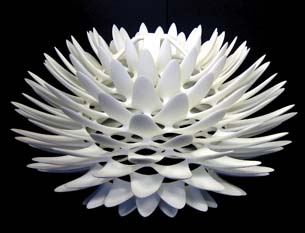 An intricately patterned polymer lampshade for a hanging light fixture, made on 3D Systems selective laser sintering (SLS) equipment. Image courtesy Freedom of Creation. |
Electron Beam Melting (EBM) represents another approach to creating fully dense metal parts by melting layers of powder. This process, developed by Arcam, employs a MultiBeam technology that uses fast deflection electronics (rather than optics and moving mechanical parts) to melt the powder simultaneously at multiple locations. A sequence of scans first heats the region to a certain temperature specific for different alloys, then melts the part contours, and lastly melts the bulk of the material.
Fused Deposition Modeling (FDM)is the term for Stratasys’ technology that heats and extrudes a fine-diameter filament of thermoplastic material and deposits it bit by bit along with any necessary support structures. The latter material is soluble and can be dissolved in a water-based solution. Available build materials are a number of ABS plastics, polycarbonates and polyphenylsulfone.
Film transfer imaging (FTI)produces hard plastic parts on 3D Systems’ VFlash Personal 3D Printer, curing one full layer at a time. This desktop modeler operates with a single-use recyclable cartridge that contains both the raw build material and such parts as pumps, measured dispensers, re-coaters and transporters.
Laser consolidation (LC) refers to the net-shape direct-metal process developed by Canada’s National Research Council’s (NRC) Integrated Manufacturing Technologies Institute (now marketed through Accufusion). LC bonds high-strength alloy onto edges and other features of inexpensive metal parts and tools, reducing the amount and cost of alloy use for part production and repair.
Laser engineered net shaping (LENS) systems from Optomec use a high-power laser to fuse powdered metals into fully dense 3-dimensional structures. LENS systems can process a wide variety of metals including titanium, nickel-base superalloys, stainless steels and tool steels.
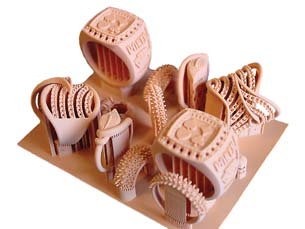 Precision jewelry models for direct investment-casting, made on an Envisiontec Perfactory Aureus DLP photopolymer system. The accuracy and level of detail make this process ideal for micro-pavé or invisible settings. Image courtesy Envisiontec. |
Laminated object manufacturing (LOM) is a general term for building a part from flat sheets of material stacked and “glued” together. The sheets are cut to shape by a laser or a blade after each layer is bonded. Previously used by now-defunct Helisys, LOM (or just “layered manufacturing”) describes the systems from two current companies.
Solido’slamination system bonds colored or clear PVC plastic sheets (cut from a roll) with glue where desired and “anti-glue” where not wanted, an approach that simplifies manually peeling away the unbound sections. An extremely low-cost LOM system is the paper-based Matrix from Mcor Technologies. This unit builds concept parts using paper sheets from a standard copy machine. Even scrap (used) paper will work.
MultiJet Modeling (MJM) is the basis for the ProJet line of equipment from 3D Systems. Similar to ink-jet 2D printers in concept, the MJM compact manufacturing systems create high-definition parts or wax castings by “jetting” various plastics, waxes and support materials.
Micro Light Build (MLB) systems have been introduced by the long-time material supplier Huntsman Advanced Materials. Using MicroLightSwitch technology based on a micro-electronic mechanical systems (MEMS) shuttering system, this AM approach enables a larger surface area of radiation-curable resin to be selectively exposed at one time, with conventional UV light instead of a focused laser beam.
Metal Printing Process (MPP) is the name for a manufacturing method in development at the UK/Norwegian research institute SINTEF. It involves an electrostatic (xerographic) photoreceptor that attracts powdered build material and support material to create one layer of a CAD-driven pattern. The material is transferred from a roller to a punch/consolidation system where each layer is sintered with pressure and heat.
PolyJet manufacturing from Objet Geometries involves jetting or squirting a liquid, acrylic-based photopolymer thorough fine nozzles in the CAD-driven shape, then curing each layer with UV light. No post-curing is necessary, and the support structure (a gel-like material) is removed easily by hand or with water. This is the only system that builds parts incorporating multiple disimilar (transparent, hard, rubbery, etc.) materials in a single build, through a dual-jet multi-print-head configuration.
 A custom metal pendant made on an EOS direct metal laser sintering (DMLS) system. Image courtesy EOS. |
Stereolithography Apparatus (SLA) refers to the original, high resolution AM process developed by 3D Systems. It produces fine-finish parts from liquid photopolymer by solidifying it with a high-definition UV laser. More than a dozen clear or opaque material choices create parts with properties of ABS and polycarbonate plastics, plastic-ceramic composites and/or high thermal resistance.
Selective Laser Melting (SLM)describes the process taken by MTT Technologies that uses a laser to melt and fuse metal parts. Materials include tool steel, aluminum, Inconel, gold alloy, titanium and cobalt chrome.
Selective Laser Sintering (SLS) uses a laser to heat and fuse powdered material into solids. The process, from 3D Systems, can be applied to various plastics, glass-filled polymers, metals, alloys, ceramics and green sand, to produce hard, flexible, fully dense or even flame-retardant parts.
Selective Mask Sintering (SMS)is another process that sinters thermoplastic powdered material. However, this approach uses an IR laser to solidify powder through a series of physical masks. The masks’ cut-out shape is generated on the fly from a roll of stock and allows exposure of a complete layer in a single flash. Sintermask Technologies is the vendor.
Ultrasonic Consolidation (UC) is perhaps the most unusual of the additive manufacturing processes. Developed by Solidica as a way to embed sensors, diagnostics and other electronics in rugged metal packaging, UC uses sound waves to merge layers of metal rolled off narrow sheet stock. The combination of bonding plus machining for each layer creates full-density parts with metallurgical bonds and works with a variety of metals.
|
The Guide to Low-Cost 3D Printers So you’ve researched the dozens of options for AM systems, have fairly simple needs and would like to spend less than $10,000. Where do you go for help? Check out the new report from Castle Island, “Everything you should know about open-source 3D printers — but didn’t know you should ask.” Researched and written by long-time industry pundit Ed Grenda, this document (29-page PDF, $9.95) covers both commercial 3D printers, such as from Stratasys and Solido, as well as the do-it-yourself open-source kits and assembled printers now on the market, from RapRep to Fab@Home to lesser-known systems. A fascinating read for anyone in the AM field, this report also offers web resources, supplies information and a look at the legal/patent angle of the business. (additive3d.com/pr_os01.htm) - PJW |
More Information:
3D Systems
Arcam
EOS
Envisiontec
ExOne
Huntsman Advanced Materials
Mcor Technologies
MTT Technologies
Objet Geometries
Optomec
POM Group
Sintermask Technologies
Solidica
Solido3D.com
Solidscape
Stratasys
ZCorporation
Contributing Editor Pamela Waterman, DE’s simulation expert, is an electrical engineer and freelance technical writer based in Arizona. You can send her e-mail to [email protected].
Subscribe to our FREE magazine, FREE email newsletters or both!
About the Author
Pamela Waterman worked as Digital Engineering’s contributing editor for two decades. Contact her via .(JavaScript must be enabled to view this email address).
Follow DE





